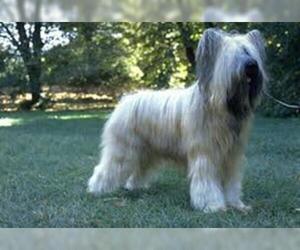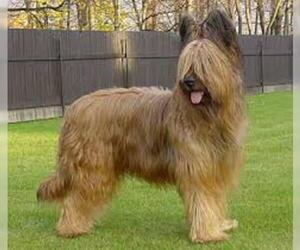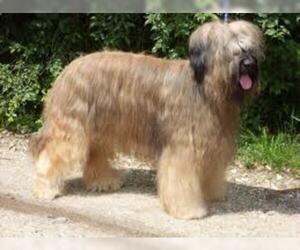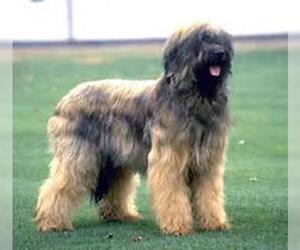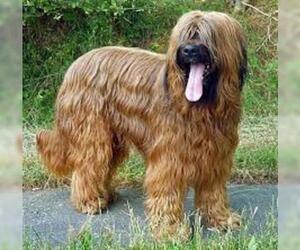
All about Briard dog breed
A.K.A. :Chien Berger de Brie, Berger de Brie, Brie Sheepdog, Briard Dog, Briard Sheepdog, French Briard, French Sheepdog, The Briard, Briard de France
Size
Grooming requirements
Exercise requirements
Good with other dogs
Watchdog ability
Energetic
Training requirements
Playful
Affectionate
Good with other pets
Good with children
Good with strangers
Winter
Summer
Healthiness
Protective
Life Span
| Pure Breeds | Member |
| Breeds A - Z | B |
| Breeds by Group | Herding |
| Breeds by Trait | Good With Kids High Stamina Dog Breeds Smartest Dog Breeds |
| Overview: | The Briard, a magnificent and ancient breed, hails from France where it was historically prized as a versatile farm dog, excelling at herding and guarding livestock. Physically, they are easily recognized by their striking, long, shaggy double coat, which can be black, grey, or tawny, giving them a rustic yet elegant appearance. Underneath all that hair is a powerful and agile physique, built for endurance. Temperamentally, Briards are known for their intelligent, loyal, and protective nature. They bond deeply with their families and often display a playful, sometimes mischievous, side. While generally good with children they’ve been raised with, their herding instincts can sometimes manifest as gentle nudging. Due to their size, energy levels, and need for mental stimulation, Briards are best suited for active families with a securely fenced yard, rather than apartment living. Potential owners should be aware of a few health concerns common to large breeds, including hip and elbow dysplasia, and bloat. |
F.A.Q.
All You Need to Know About the Briard Breed
The Briard, a magnificent French herding dog, is known for its distinctive shaggy coat and loyal, intelligent temperament. Originating in France, these powerful yet agile dogs were historically used for guarding and driving sheep. Physically, they boast a long, flowing double coat (requiring regular grooming to prevent mats) and expressive eyes. Briards are generally excellent family dogs, forming strong bonds with their human companions, though early socialization and consistent training are crucial due to their protective instincts and strong will. While adaptable, their substantial exercise needs make them less suitable for small apartment living; a home with a yard and an active lifestyle owner is ideal. Common health considerations include hip and elbow dysplasia, bloat, and eye issues. Prospective owners should be prepared for a devoted, active, and sometimes vocal companion who thrives on engagement and purposeful work.Briard Weight: Average Size & Healthy RangeThe average healthy weight for an adult Briard is between 75-100 pounds.* Males (Dogs): Typically fall into the higher end of the range, from 80-100 pounds.* Females (Bitches): Generally weigh between 75-90 pounds.This range represents the healthy weight for Briards, ensuring they are not overweight or underweight. Potential adopters should consider these figures when looking for a Briard, as they indicate the typical substantial size of this breed.
Wondering how tall is a Briard? These magnificent French herding dogs have an impressive stature! The average height of a Briard typically falls within a well-defined range, measured at the shoulder (withers).
For adult Briards, you can expect a height range of approximately 22 to 27 inches.- Male Briards generally stand between 23 to 27 inches tall.
- Female Briards are usually slightly smaller, ranging from 22 to 25.5 inches in height.
The Briard breed colors officially recognized by major kennel clubs like the AKC are black, fawn (ranging from light to dark), and grey (ranging from light to dark). These are the standard AKC recognized Briard colors you'll typically find. Variations in these core colors include a warm, honey-like fawn, a deep slate grey, or a rich, solid black. While these are the accepted show colors, some rare Briard coat types and exotic Briard variations do exist, though they are not recognized for conformation by the AKC. These include blue, cream, white, brindle, chocolate, and merle. Blue Briards have a diluted black coat, while cream and white are very light fawn or heavily diluted colors. Brindle Briards display a striped pattern, and chocolate Briards have a reddish-brown hue. Merle Briards have patches of diluted color on a darker base. It's important to note that Briards with these exotic Briard variations are not eligible for AKC conformation showing and may be priced differently due to their rarity or unaccepted status. Always prioritize the health and temperament of a Briard, regardless of its coat color.
The Briard personality is renowned for its unique blend of intelligence, loyalty, and spirited independence. Often described as a "heart wrapped in fur," they form extremely strong bonds with their families, displaying an unwavering devotion that makes them exceptional companions. Briard temperament is generally friendly, but they are also watchful and can be protective, making them excellent natural guardians without being overly aggressive. Their herding instincts often lead to a desire to keep their "flock" (family members) together.
Sociability is a key trait; Briards thrive on interaction and being part of family activities. They are not dogs to be left isolated in a backyard. Early and consistent socialization is crucial to ensure they are well-adjusted to new people and situations. While they can be initially reserved with strangers, a well-socialized Briard quickly becomes accepting.Adaptability to apartment living is generally not ideal for a Briard. They are large, active dogs with significant exercise needs. A home with a secure yard is much preferred, allowing them space to run and play. However, if their physical and mental exercise requirements are met daily through long walks, runs, or engaging activities, they can adapt to smaller living spaces, though it requires dedicated effort from their owners.When it comes to behavior with children and other pets, Briards typically excel, especially when raised with them from a young age. Their protective and gentle nature often extends to children, treating them as part of their flock. However, due to their size and herding instincts, supervision is always recommended, particularly with very young children, to prevent accidental bumps or playful nipping (which can be a herding trait). With other pets, particularly cats and smaller animals, early introduction and socialization are key. Many Briards coexist peacefully with other dogs, but their strong personalities may mean they prefer to be the sole canine focus or require careful management in multi-dog households.In essence, the Briard is a deeply loving, intelligent, and energetic companion best suited for active families who can provide consistent training, ample exercise, and include them as a central part of their lives. Their playful spirit and devoted nature make them truly unforgettable.The Briard temperament is renowned for its loyal, protective, and intelligent nature. These magnificent companion dogs form deep bonds with their families, often exhibiting a "velcro dog" tendency to stay close. Friendliness & Sociability: While generally affectionate and gentle with children they've been raised with, Briards can be reserved or cautious with strangers. Early and consistent socialization is crucial to foster a well-adjusted adult. They typically get along well with other household pets when properly introduced and socialized, though their herding instincts might cause them to "herd" smaller animals.Stubbornness & Sensitivity: Briards possess a keen intelligence but can also be stubborn, requiring patient and consistent positive reinforcement training. They are sensitive to harsh tones and respond best to calm, encouraging methods. Their sensitivity also means they thrive on human companionship and can develop separation anxiety if left alone for extended periods.Adaptability to Apartment Living: Due to their size, energy levels, and need for mental stimulation, Briards are not ideal for apartment living. They require a secure yard and daily exercise, including walks and playtime, to prevent boredom and destructive behaviors. They are active dogs that enjoy having a "job" to do.Key Personality Traits: Expect a playful, watchful, and sometimes comical companion who is always ready for an adventure. Their protective instincts make them excellent watchdogs. With proper training and socialization, the Briard is a devoted and rewarding family member.
Briard care involves specific daily maintenance and long-term health considerations. These are generally low-energy dog breeds, but still require regular, moderate exercise to prevent boredom and maintain muscle tone. Daily walks and playtime are usually sufficient.
Grooming needs are significant due to their long, coarse double coat. Expect daily brushing to prevent mats and tangles, especially around the ears and legs. Professional grooming every 6-8 weeks is often recommended for trimming and thorough cleaning. Occasional baths are needed to keep their coat healthy and clean.Dietary considerations involve a high-quality kibble formulated for large breeds, with careful attention to portion control to prevent obesity. They are prone to bloat, so consider elevated feeding bowls and avoid strenuous exercise immediately after meals. Monitor for food sensitivities.While Briards aren't truly brachycephalic, they can be sensitive to extreme heat due to their dense coat. Provide plenty of shade and water in warm weather, and avoid over-exertion. They generally tolerate colder climates well.Essential daily maintenance includes regular dental care (brushing several times a week), nail trims every 2-4 weeks, and ear cleaning weekly to prevent infections. Check paws regularly for foreign objects.Common health concerns include hip and elbow dysplasia, progressive retinal atrophy, and bloat. Regular veterinary check-ups are crucial for early detection and management. Skin issues can arise if their coat isn't properly maintained, so consistent grooming is a key preventative measure. Weight management is vital to prevent joint strain and other health problems, making appropriate diet and exercise paramount. For more on how to care for a Briard, consult your veterinarian and experienced breeders.Briard Activity Level: How active are Briard? Briards have a moderate to high activity level. They are not brachycephalic, so their exercise isn't limited by respiratory issues. These intelligent herding dogs possess a surprising balance, capable of short bursts of intense energy followed by long periods of rest. They thrive on daily exercise to keep their minds and bodies healthy. Expect at least 60-90 minutes of dedicated activity per day, which can include brisk walks, jogging, hiking, and especially mentally stimulating activities like herding, obedience, or agility training. Briards love to play and engage with their families; interactive games like fetch or hide-and-seek are excellent for their physical and mental well-being. Due to their independent nature and strong guarding instincts, early socialization and consistent training are crucial to channel their energy constructively. While they enjoy active pursuits, they are not hyperactive and appreciate downtime with their families. They are suitable for active families who can commit to their exercise needs and mental stimulation, but generally not for low-energy households, as an under-exercised Briard can become bored and destructive.
Breed Breakdown: What Experts Say About the Briard
I would rate the "Size" trait of the Briard at a 7.Briards are undeniably large dogs. They typically stand between 22 to 27 inches tall at the shoulder and can weigh anywhere from 70 to 100 pounds, with some individuals exceeding that. Their robust, muscular build and long, shaggy coat further contribute to their substantial appearance. When compared to the vast majority of companion dogs, which include small terriers, lapdogs, and even many medium-sized breeds, the Briard clearly falls into the larger category. They possess a significant physical presence that demands ample space. Due to their size, Briards are generally not well-suited for apartment living or households with significant space constraints. While they are adaptable and desire to be with their families, a small living area would restrict their ability to move comfortably and potentially lead to behavioral issues due to pent-up energy. Travel can also be challenging due to their bulk, often requiring larger vehicles or specialized crates. They thrive in homes with a yard and room to roam, where their impressive stature can be accommodated.
I would rate the grooming requirements of the Briard a 8/10. The Briard's defining feature is its long, shaggy double coat, which is the primary reason for its high-maintenance rating. This coat, while beautiful, is prone to matting and requires very frequent, thorough brushing, ideally several times a week, to prevent knots and keep it healthy. Owners should expect to dedicate significant time to line brushing to reach the undercoat. While Briards aren't excessive shedders, their long hair means any shedding is more noticeable and still requires regular removal. Beyond the coat, their floppy ears need regular cleaning to prevent infections, and nail trimming is important like any dog. Bathing needs are moderate, but drying their thick coat completely can be time-consuming. They generally have good skin, but their dense coat can hide issues if not groomed regularly. Compared to many other companion dogs, the Briard definitely requires frequent and specialized grooming efforts to maintain its coat in good condition and prevent discomfort for the dog.
I would rate the Exercise Requirements of the Briard at a 7.Briards are a herding breed, and as such, they possess a significant amount of energy and a strong desire to work. They are not a breed that will be content with minimal activity; they thrive on structured routines and purposeful movement. Daily, vigorous exercise is essential to keep them physically healthy and mentally stimulated. This can include long, brisk walks, jogging, hiking, or off-leash play in a secure area. Their intelligence and agility make them excellent candidates for dog sports like agility, obedience, and even herding trials. While they can enjoy a good game of fetch, simply tossing a ball in the backyard won't fully satisfy their need for sustained movement and mental engagement. They don't have the respiratory limitations of brachycephalic breeds, allowing them to participate in more strenuous and prolonged activities. Without adequate exercise, Briards can become bored, destructive, and even anxious. They require an owner committed to providing consistent and engaging physical outlets to ensure they are well-behaved and happy companions.
I would rate the Briard's "Watchdog Ability" at a 9.The Briard is an excellent watchdog, deeply rooted in its history as a herding and guarding breed. They are incredibly alert and possess keen senses, quickly picking up on unusual sounds or sights within their territory. Their barking behavior is typically purposeful – a deep, resonant bark that effectively signals an intruder's presence. Briards are naturally territorial and bond strongly with their family, viewing their home as their domain to protect. When faced with an unfamiliar person or sound, they will typically assess the situation carefully, often with a watchful stance and a warning bark. While not inherently aggressive, their size, powerful presence, and willingness to stand their ground act as a significant deterrent to potential intruders. They are certainly not passive companions; they are capable of providing meaningful and impactful early warnings in a home environment and will actively work to deter perceived threats to their family and property.
I would rate the "Good with Other Dogs" trait of the Briard as a 7 out of 10.Briards are generally known for being good with other dogs, especially those within their own "pack" or family. They are often playful and tolerant with familiar canine companions, demonstrating their herding instincts by sometimes gently "managing" other dogs' movements. However, this rating reflects that while they are not typically aggressive, they do possess a strong protective instinct and can be discerning, especially with unfamiliar dogs. Their large size and impressive appearance can sometimes be misinterpreted, and a Briard's initial greeting might involve a confident, watchful stance. They tend to be more compatible with dogs of similar energy levels who can keep up with their active play, though they can learn to coexist peacefully with smaller or less active dogs with proper socialization. Early and consistent socialization is crucial for Briards to ensure they learn appropriate dog-to-dog etiquette. Without it, they might develop a tendency towards being overly protective of their people or territory, which could manifest as dominance or wariness with strange dogs. In multi-dog households, they often thrive, particularly if introduced as a puppy or if the existing dogs are calm and well-adjusted. While they generally don't seek out conflict, they are not a breed that will back down from a challenge if they feel threatened or believe their family is in danger. Therefore, careful introductions and ongoing training are important to ensure they remain polite and well-behaved around all dogs, rather than simply expecting them to be universally friendly without guidance. They thrive in canine company when properly socialized and understand their role, but they are not a breed that is universally and indiscriminately sociable with every dog they encounter.
I'd rate the "Energetic" trait of the Briard a 7 out of 10.Briards are naturally active and possess a good deal of stamina, reflecting their heritage as herding dogs. They are not typically laid-back companion dogs that are content with minimal exercise; rather, they thrive on having a job to do or a purposeful activity. Their endurance allows them to participate in long walks, hikes, and various dog sports like agility, obedience, and herding trials. They exhibit a playful nature, especially when young, and their need for physical and mental stimulation is moderate to high to prevent boredom and destructive behaviors. While they aren't quite the perpetual motion machines of some high-drive working breeds, their energy level is consistently higher than many other companion dogs. It's important to note that the Briard does not possess brachycephalic anatomy. They have a well-proportioned muzzle, which means their respiratory system is not inherently compromised and does not negatively affect their stamina or exercise tolerance. This allows them to maintain their activity levels without the breathing difficulties that flat-faced breeds might experience during exertion.
The Briard's "Training Requirements" rate a 7 out of 10.While highly intelligent and capable of learning a wide array of commands, Briards are also known for their independent and sometimes stubborn nature, true to their herding roots. This means training requires significant consistency, patience, and a firm yet gentle hand. Their attention span can be good when engaged, but they can also get bored or decide they have a "better idea" if not stimulated. They respond very well to positive reinforcement, but it needs to be delivered consistently and enthusiastically to maintain their focus and motivation. They are not typically a beginner-friendly breed; their training is most effective with experienced handlers who understand canine psychology, especially the nuances of a working breed. A structured routine and early, consistent socialization and obedience training are crucial to developing a well-mannered Briard.
Rating the Briard's "Playful" trait, I'd give them a 7 out of 10.Briards are not typically described as hyperactive or constantly seeking a rousing game of fetch in the way some other breeds might be. However, they possess a deep-seated playfulness that manifests in a more mature, yet still very engaging, way. They absolutely love games and interaction with their family, often initiating playtime with a nudge of their head or by bringing a toy. Their herding background means they enjoy "working" with you, and this translates into enthusiastic participation in games like hide-and-seek, puzzle toys, and even just a good wrestling session. While they can be content to lounge nearby, when the opportunity for fun arises, they light up with enthusiasm, exhibiting joyful leaps and playful nips (usually gentle). They respond very well to toys and human interaction, often showing a surprising amount of agility and stamina when engaged. They are spirited and enjoy being a part of the family's activities, but they also have an "off switch" and aren't typically bouncing off the walls. Compared to some more consistently boisterous companion dogs, they are perhaps a touch more laid-back, but their love for playful engagement is undeniable and enduring throughout their lives.
The Briard's "Affectionate" trait rates a 9 out of 10.Briards are deeply devoted and loving dogs, forming strong bonds with their families. They possess an intense desire for human companionship and thrive on being part of their owner's lives. While not typically "lap dogs" due to their size, they are very physically affectionate, often leaning into their owners, nudging for attention, and enjoying a good cuddle session on the floor or couch. Their loyalty is unwavering, and they are highly sensitive to their owner's emotions, offering comfort or sensing when they are needed. Briards are known for their "shadow" tendencies, following family members from room to room, preferring to always be in the same vicinity. They are not independent in the sense of being aloof; rather, their independence manifests in their strong will and intelligence, but their heart's desire is always to be close to their people and receive and give affection. They truly thrive on affection and become distressed if left alone for extended periods.
I would rate the "Good with Other Pets" trait of the Briard breed as a 6.Briards are generally intelligent and trainable, and with proper early socialization, they can learn to coexist peacefully with other pets, including dogs and cats. They often form strong bonds with their "flock," which can extend to other household animals. However, their strong herding instinct can sometimes manifest as an attempt to "herd" smaller, faster pets, which might not always be appreciated by the other animal. Their prey drive is moderate; while not typically aggressive towards small animals, a lack of early exposure could lead to them viewing a fleeing cat or small dog as something to chase. Resource guarding, especially with food or toys, can occur if not managed through training and clear boundaries from a young age. Therefore, while capable of being pet-friendly, they are not naturally universally sociable and require consistent training, early and varied socialization, and continued supervision to ensure peaceful coexistence in a multi-pet household. They are adaptable but thrive best when introduced thoughtfully and given clear guidance on appropriate interactions.
Rating the Briard's "Good with Children" trait, I'd give them a solid 7 out of 10. They are generally patient and protective, displaying a natural inclination to include children in their "flock." Their playful energy makes them excellent companions for active children, often enjoying games of fetch or romping in the yard. Briards are also known for their tolerance of noise and the sometimes clumsy handling that comes with younger children, thanks to their stable and even temperaments.However, their strong herding instincts mean they might try to "herd" smaller children, which, while not aggressive, can be overwhelming for some. This can be managed with early training and supervision, teaching both the dog and the children appropriate interactions. While naturally gentle and affectionate with their own family, their sheer size and boundless energy require them to be taught good manners around kids. They thrive in a family setting where they are active participants, and with proper socialization and guidance, they can be wonderfully devoted and fun-loving companions for children of all ages.
The Briard breed typically rates a 4 out of 10 for the "Good with Strangers" trait. While not inherently aggressive or actively unfriendly, Briards are naturally reserved and protective, falling far from the "extremely sociable and welcoming" end of the spectrum. Their historical role as herders and guardians has instilled a strong sense of territoriality and a cautious demeanor towards unfamiliar adults. They are unlikely to be immediately friendly or outgoing with strangers; instead, they tend to observe new people with a watchful intensity. Briards will generally tolerate the presence of guests in their home once they understand the stranger has been "approved" by their family, but they rarely seek out interaction or solicit attention from them. In public or guest-filled environments, they are adaptable in the sense that they won't necessarily cause a scene, but they will remain vigilant and generally aloof. While training can certainly help them be polite and well-behaved around strangers, it does not fundamentally alter their intrinsic wariness. They are not a breed that will readily bark at every new face, but their quiet observation can be a form of guarding. Early and extensive socialization is crucial to ensure they are comfortable rather than just tolerant, but even then, a Briard's natural inclination is to be reserved and discerning rather than openly welcoming to those outside their immediate circle.
I would rate the Briard's winter tolerance at a 8. They possess a thick, double coat that provides excellent insulation against cold temperatures, acting as a natural barrier to the elements. Their substantial size and muscular build also contribute to their ability to retain body heat. Unlike brachycephalic breeds, their normal muzzle length doesn't hinder respiration in cold air. While they are resilient, it's important to remember that no dog is completely impervious to extreme cold. They can safely enjoy outdoor activities in cold climates for extended periods, but during severe blizzards or prolonged exposure to sub-zero temperatures, even a Briard will benefit from access to shelter. Compared to many shorter-coated or smaller companion dogs, Briards require significantly less special care during winter months, largely due to their robust natural defenses. However, owners should still be mindful of ice on their paws and ensure their coat is kept free of mats, which can reduce its insulating properties.
The Briard breed would rate a 3 for "Summer" tolerance.While not brachycephalic, their thick, double coat provides substantial insulation, making them highly susceptible to overheating. They have a limited ability to regulate their body temperature effectively in warm climates due to this dense fur. This significantly increases their risk of heatstroke, especially during prolonged or strenuous outdoor activity. During hot weather, outdoor activity levels should be severely restricted, primarily limited to early mornings or late evenings when temperatures are cooler, and even then, only for short durations. They absolutely require climate control during hot weather, meaning access to air conditioning or other cooled environments is crucial. Compared to many other companion dogs, the Briard requires special and meticulous care in summer months, including constant access to fresh water, avoiding direct sun, and a strong emphasis on staying indoors in a cool environment, often necessitating a complete alteration of their exercise routine to ensure their safety.
I would rate the Briard's "Healthiness" trait as a 7 out of 10.The Briard is generally a robust and healthy breed compared to many other companion dogs. They boast a respectable life expectancy of 10-12 years, and often longer with good care. Responsible breeding practices have largely focused on maintaining their working dog characteristics, which inherently contributes to a sounder constitution. They are not typically considered high-maintenance in terms of health, but rather moderately so due to some breed-specific predispositions.While not plagued by the same severe breathing difficulties seen in brachycephalic breeds or the widespread joint issues of some giant breeds, Briards do have some notable genetic predispositions. Hip and elbow dysplasia are concerns, though reputable breeders screen for these conditions, and the severity is often less than in some other large breeds. Bloat (gastric dilatation-volvulus) is a serious and acute risk, as it is with many deep-chested breeds, making owner awareness and preventive measures crucial. Eye conditions like progressive retinal atrophy (PRA) and congenital stationary night blindness (CSNB) are also known within the breed, which responsible breeders test for to avoid passing them on. Skin conditions are not a primary widespread concern but can occur like in any breed. Overall, with good nutrition, regular exercise, and proactive veterinary care (including screening for known issues), a Briard can live a long and fulfilling life without excessive health interventions. Their health is generally solid, but not entirely without specific considerations that prevent a perfect score.
I would rate the "Protective" trait of the Briard at a strong 9 out of 10.The Briard is an inherently protective breed, deeply loyal to its family and possessing strong territorial instincts. Their historical role as herding dogs included guarding the flock, and this watchful nature translates directly to their home environment. They are highly alert and keenly aware of their surroundings, quick to notice anything out of the ordinary. Strangers approaching their property or family are met with suspicion and often a deep, resonant bark, serving as an excellent deterrent. While they are ultimately companion dogs, their size, powerful build, and unwavering dedication to their owners make them exceptionally capable of offering meaningful protection in a household setting. They will not hesitate to place themselves between their family and a perceived threat, making them not just excellent watchdogs, but also formidable guard dogs.
I would rate the "Life Span" trait of the Briard breed as a 7 out of 10.Briards are generally considered to have an average to slightly above-average lifespan compared to other large dog breeds, and even companion dogs in general. Their average life expectancy typically falls between 10 to 12 years, with many individuals living longer. While they aren't considered exceptionally long-lived like some smaller breeds, they rarely fall into the "short-lived" category.Common health issues that can impact their longevity include gastric torsion (bloat), hip and elbow dysplasia, and certain eye conditions, which are prevalent in many large breeds. However, responsible breeding practices aim to screen for these genetic predispositions, and diligent care regarding diet, exercise, and veterinary check-ups can significantly mitigate their impact. When well-cared for, a Briard can enjoy a healthy and fulfilling life well into their senior years.
Briard Dogs for adoptionSee all dogs for adoption
Briard BreedersSee all breeders
Similar Dog Breeds for Briard
Quick Breed Selector 0 - not important, 1 - smallest, 10 - largest
Variants & Mistakes :Briar, Brainard, Bryard, Breard, Briaird, Braird, Briart, Brird, Biard, Briardd, Briared, Briardes, Briardi, Briardo, Briards, Breiard, Bryiard, Breardd, Brayard, Briardian, Briardien, Briardine, Briardly, Briarred, Briarwood, Briary, Breiardd, Bryardd, Brainardd, Briair, Briardt, Brirard, Briardr, Briarde, Briare, Briardz, Briardx, Briardc, Briardv, Briardb, Briardn, Briardm, Briar d, Bri ard, Briad
